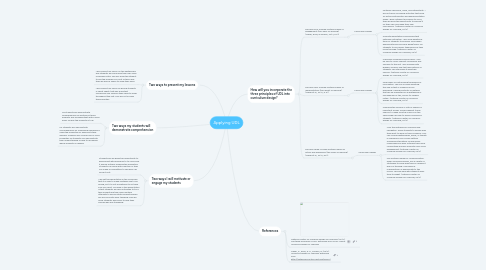
1. Two ways to present my lessons
1.1. I will present my lesson on the whiteboard and students will each have their own copy of guided notes. This will allow the student to see the problems in front of them and they will have a space to show their work.
1.2. I will present my lesson by giving students a "cheat sheet" that has important vocabulary and symbols they need to know throughout the unit. This will not include the properties.
2. Two ways my students will demonstrate comprehension
2.1. My students will demonstrate comprehension by writing out each property and following that with a small proof on why the property is true.
2.2. My students will demonstrate comprehension by simplifying expressions using the properties of exponents they defined. Problems will include one or more properties so students can demonstrate their understanding of how to recognize which property is needed.
3. Two ways I will motivate or engage my students
3.1. Students will be given the opportunity to experiment with problems to try and solve it before actually knowing the properties. Students can work with a partner or they can make a competition to see who can solve it first.
3.2. I will set the expectation in the classroom that it is okay to make mistakes and to be wrong, but it is not acceptable to not give your full effort. My hope in this expectation is that students will feel motivated to try if they understand they have multiple attempts to demonstrate understanding. I will also promote peer teaching. This will allow students who excel to help their friends who are struggling.
4. How will you incorporate the three principles of UDL into curriculum design?
4.1. Principle One: Provide multiple means of engagement (the "why" of learning) (Meyer, Rose, & Gordon, 2014, p.51)
4.1.1. Curriculum Design
4.1.1.1. Optimize relevance, value, and authenticity. I will do this by providing activities that allow for active participation and experimentation. When I give a student a problem to solve, they will have the opportunity to explore it on their own and make their own conclusions. (National Center on Universal Design for Learning, 2014)
4.1.1.2. Promote expectations and beliefs that optimize motivation. I will allow additional time for students to problem solve when appropriate and provide a guide/rubric for students to self assess themselves as they move through. (National Center on Universal Design for Learning, 2014)
4.2. Principle Two: Provide multiple means of representation (the "what" of learning) (Meyer et al., 2014, p. 51)
4.2.1. Curriculum Design
4.2.1.1. Clarifying vocabulary and symbols. I will be sure to cover relevant vocabulary and symbols to the unit. I will provide both graphic symbols and text descriptions so students can internalize it how they choose. (National Center on Universal Design for Learning, 2014)
4.2.1.2. Offer ways of customizing the display of information. This can include adjusting the size of text or images you are displaying. Having printouts of material that will be presented on a whiteboard is one example of this, similar to "guided notes." (National Center on Universal Design for Learning, 2014)
4.2.1.3. Checking the volume or rate of speech is important as well. Doing frequent "temp checks" to make sure the class is on the same page can help to avoid confusion in students. (National Center on Universal Design for Learning, 2014)
4.3. Principle Three: Provide multiple means of action and expression (the "how" of learning) (Meyer et al., 2014, p.51)
4.3.1. Curriculum Design
4.3.1.1. Vary the methods for response and navigation. Allow students to decide how they want to work on their problems. This can include whiteboards, paper, or tablets if available in your school setting. Providing alternatives for physically responding can help a student feel more comfortable and will promote more class engagement. (National Center on Universal Design for Learning, 2014)
4.3.1.2. Use multiple media for communication. When solving problems, use a variety of strategies to show how there is different ways of thinking. Use physical manipulative's if appropriate to the lesson. This will help with students who tend to fidget. (National Center on Universal Design for Learning, 2014)
